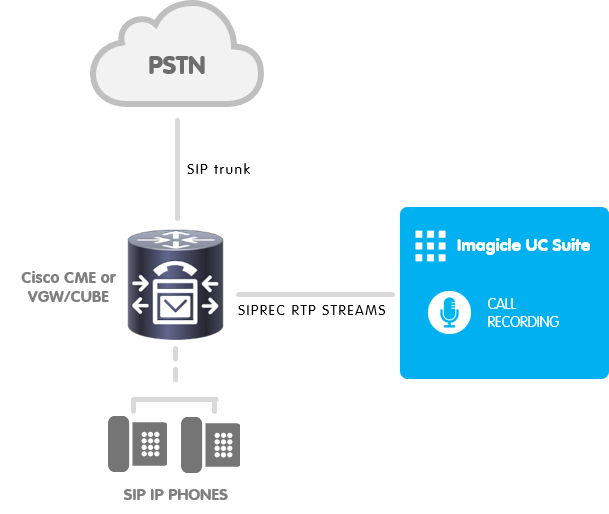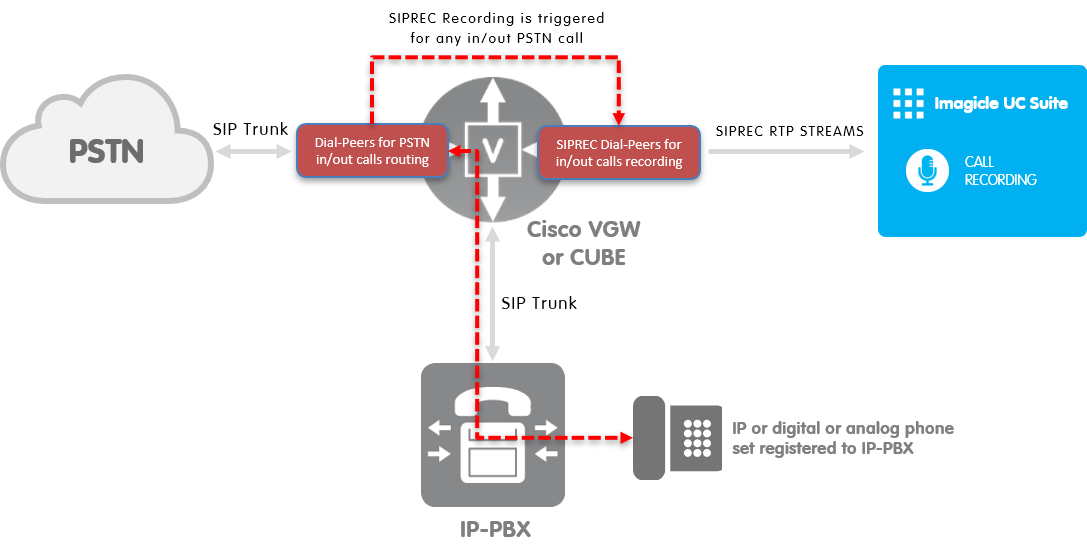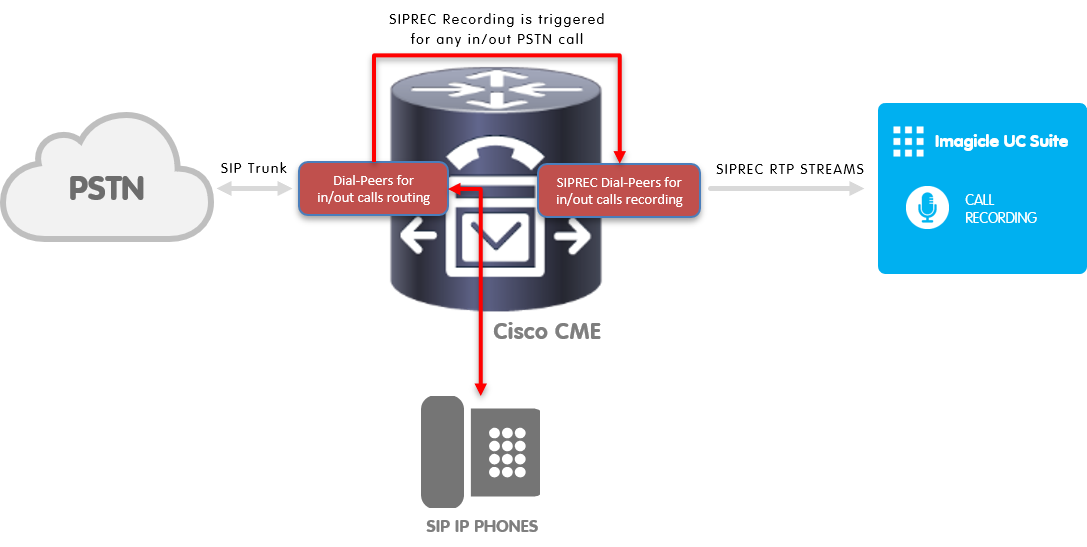The Session Recording Protocol (SIPREC) is an open SIP-based protocol for call recording standard, defined by Internet Engineering Task Force (IETF). It is supported by many IP-telephony platforms and call recording system vendors.
Imagicle SIPREC-based Call Recording solution, available starting from 2019.Spring.1 release, is a good fit in all Always-On recording scenarios where offnet and optionally on-net calls must be recorded. Many vendors’ PBXs and gateways already support SIPREC standard. Cisco supports it on CUBE and CCME, starting from Cisco IOS 15.6(1)T or Cisco IOS XE 3.17S versions.
Architecture
In order to record audio conversations leveraging SIPREC technology, all calls should be routed using SIP protocol. A SIPREC media forking trigger point should be configured within your IP-PBX or your gateway, to generate recording RTP streams toward Imagicle Call Recording appliance.
See below a general architecture scenario:

It is very important to understand that SIPREC requires SIP-to-SIP routing, so basically a SIP IP Phone can record calls if they are coming/routed from/to a SIP Trunk toward PSTN (Cisco CME case) or a SIP Trunk toward a SIPREC-enabled Voice Gateway/CUBE (IP-PBX case).
Limitations
Configurations described by this article have the following limitations:
- SIPREC recording requires Imagicle UC Suite for Cisco UC version 2019.Spring.1 or above.
- A flat dial-plan must be adopted: multiple phones having the same directory number are not distinguishable from the Call Recording service perspective. Neither the device name nor the MAC address of the phone cannot be used to distinguish devices with shared lines or overlapping numbers.
- Cisco IP Phones should be registered to CUCM or CME using SIP. SCCP is not supported.
- Only SIP-based PSTN accesses are supported. Analog/ISDN trunks are not supported.
- SIPREC recording does not work while TCL scripts are running on Cisco VGW or Cisco CME.
- Calls passing through IVR/ACD systems (native or third party) are not supported.
- Complex call scenarios involving multiple parties are supported: the recording is always assigned to the original calling or the final called party number. This includes the following scenarios:
- Forwarded calls
- Call transfers
- Conference calls
- Call pickup
- Single Number Reach
- Answering groups (hunt pilots)
See here for further details.
SIPREC recording of PSTN calls on Cisco CUBE or Cisco CME
This record method is suitable for the following scenarios:
- Cisco CUBE as “Session Border Controller”, to grant SIP-based PSTN access to your PBX (Cisco UCM or any other IP-PBX). See below:

- Cisco CME, with carrier’s SIP trunk toward PSTN. See below:

Both Cisco CUBE or Cisco CME should include NN x trunk licenses "CUBE-T-STD" to trigger SIPREC recording, where NN is the total number of concurrent calls to be recorded (calculation must include conversations on hold, on phone lines enabled to Imagicle Call Recording).
Configurations on Cisco Gateway (CUBE or CME appliance)
In this scenario, two media class with relevant media profile should be defined, respectively for inbound and outbound PSTN calls recording using SIPREC:
- Inbound PSTN calls:
media profile recorder 101 description MEDIA PROFILE TO IMAGICLE RECORDER - INBOUND CALLS media-type audio media-recording 9001 ! media class 101 recorder profile 101 siprec
-
Outbound PSTN calls:
media profile recorder 100 description MEDIA PROFILE TO IMAGICLE RECORDER - OUTBOUND CALLS media-type audio media-recording 9000 ! media class 100 recorder profile 100 siprec
Then you need to amend existing dial-peers to route inbound and outbound calls, by respectively adding above defined SIPREC media-class. See below sample:
dial-peer voice 7100 voip
description INCOMING CALLS FROM PSTN
|
|
|
media-class 101
codec g711alaw
dtmf-relay cisco-rtp
no vad
!
dial-peer voice 7000 voip
description OUTGOING CALLS TO CARRIER SIP TRUNK
|
|
|
media-class 100
codec g711alaw
dtmf-relay cisco-rtp
no vad
!
The following dial-peer voip must be created from scratch, to record incoming PSTN calls, including a specific voice class sip-profile to customize SIP INVITE “From” header:
voice class sip-profiles 101request INVITE sip-header From modify "<sip:(.*)>(.+)" "<sip:\1;x-incoming;x-anchor-index=1>\2"!dial-peer voice 9001 voip description Imagicle SIPREC Server (incoming calls recording) destination-pattern 9001 session protocol sipv2 session target ipv4:<IAS_IP>:5070 <-- Imagicle Recorder’s IP voice-class sip profiles 101 session transport tcp voice-class sip options-keepalive up-interval 10 down-interval 10 retry 3 codec g711ulaw dtmf-relay rtp-nte no vad !
The following dial-peer voip must be created from scratch, to record outgoing PSTN calls, including a specific voice class sip-profile to customize SIP INVITE “From” header:
voice class sip-profiles 100request INVITE sip-header From modify "<sip:(.*)>(.+)" "<sip:\1;x-outgoing;x-anchor-index=1>\2"!
dial-peer voice 9000 voip description Imagicle SIPREC Server (recording outgoing calls) destination-pattern 9000 session protocol sipv2 session target ipv4:<IAS_IP>:5070 <-- Imagicle Recorder’s IP voice-class sip profiles 100 session transport tcp voice-class sip options-keepalive up-interval 10 down-interval 10 retry 3 dtmf-relay rtp-nte codec g711ulaw no vad !
Other supported SIPREC recording scenarios
SIPREC recording with analog/TDM trunks to PSTN
Imagicle Call Recording allows to leverage SIPREC technology to record calls routed to analog or TDM-based PSTN trunks. In this case, while the call is not fully SIP-to-SIP, it is required to add "Hairpin" dial-peers to engage a SIP-to-SIP call leg and trigger SIPREC recording streams. See below sample scenario including Cisco CME:
.png) SIPREC to record internal calls between analog phones
SIPREC to record internal calls between analog phones
Internal calls involving analog phones can be recorded too, again involving "Hairpin" dial-peers to loopback analog calls through a Cisco CUBE. See below a sample scenario including IP-PBX and a dedicated CUBE for recording purposes:

Configuration on Imagicle side
In order to enable SIPREC recording, it is required to properly license the UC Suite by channels or users. Moreover, the following settings should be applied from Imagicle UC Suite web portal for Administrators:
- Users’ management:
- Please add a user for each internal extension number you need to enable for SIPREC recording.
- Users’ permission: each recording-enabled user should have at least the permission level "(2) Record Only"
- Call Recording Global parameters:
- Internal or external data Storage, with retention policies
- Email notifications, if required.